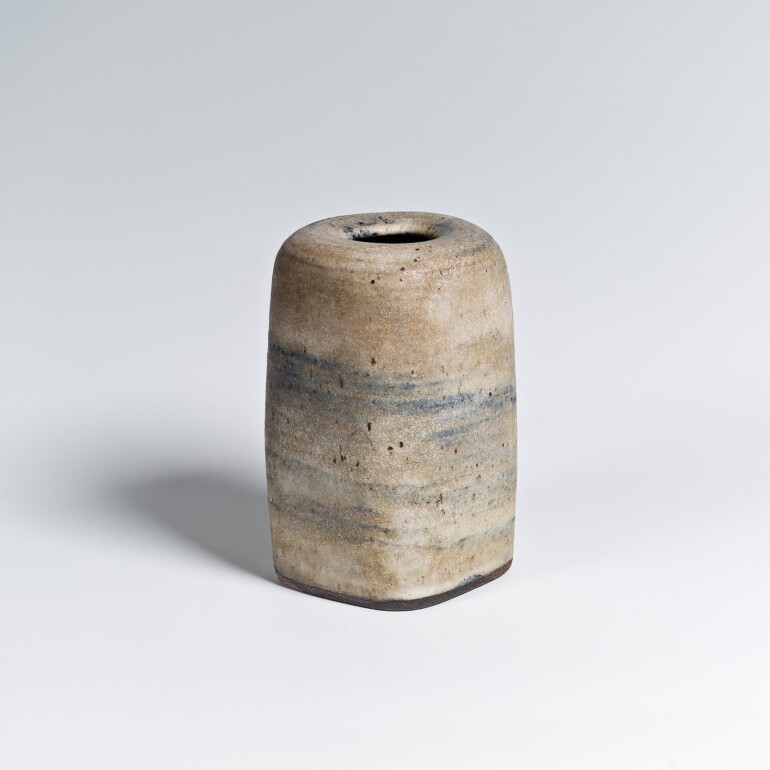Text by Sarah Wetzlmayr
Lucie Rie (1902–1995) is considered one of the most influential ceramic artists of the 20th century. Yet her work continues to defy simple categorization. She cared neither for artistic labels nor for theoretical explanations—her focus was always on the act of making, on direct engagement with the material. Her vessels, created over decades between Vienna and London, possess a quiet austerity that deliberately eludes conventional classifications. To truly engage with her work means paying attention to what is not immediately visible.
When asked whether she saw herself more as an artist or a craftswoman, Lucie Rie usually responded curtly: »I am a potter.« A sentence that unequivocally shows that the ceramist, born in Vienna in 1902, preferred not to dwell on such classifications—and their hierarchical implications. Nor did she want to philosophize at length and expansively about her work, as author and ceramist Edmund de Waal reports. She once answered an inquiry about a contribution to a book as follows: »I do not want to be in your book. I like to make pots—but I do not like to talk about them. I would answer your questions today, but they would be wrong tomorrow.« This statement, which de Waal classifies as a typically Viennese method »of getting to the point,« contains two insights about Lucie Rie.

On the one hand, everything in the influential ceramist’s life truly revolved around making; on the other hand, this more-than-direct answer also encapsulates Rie’s view that every new piece of ceramic is a new beginning. »To make pots is an adventure to me, every new work is a new beginning,« is one of Lucie Rie’s most frequently quoted sentences. Vienna was the starting point of her journey, consisting of countless small adventures. Lucie Rie, then still Luzie Gomperz, was born in 1902 in the Austrian capital and grew up in a middle-class Jewish home. Her childhood and youth were significantly shaped by her uncle Sándor Wolf, a respected Burgenland businessman with a large collection of ancient art treasures from various cultures. The fact that Roman pottery was among them significantly influenced Lucie Rie. »There were these fantastic Roman bowls that were floating. I always tried to copy those floating bowls,« she recalled many years later about her first encounters with her uncle’s ancient ceramic collection.
FROM VIENNA TO LONDON
Her artistic talent became apparent very early on, and on the advice of her private drawing teacher, she attended the Kunstgewerbeschule in Vienna, where prominent artists such as Oskar Kokoschka and Josef Hoffmann taught. However, Lucie Rie was particularly drawn to Michael Powolny’s ceramics class. Yet, it was not he, but the architect and co-founder of the Wiener Werkstätte, Josef Hoffmann, who considered her first self-made vessel so good that he exhibited it in Brussels’ Palais Stoclet. As Tony Birks notes in his comprehensive biography Fired Earth, »Lucie’s work at the potter’s wheel was characterized by a rational approach and determination. She had internalized the design concept of the early Secession and the Wiener Werkstätte, originally derived from architecture, according to which all everyday objects, from wallpaper patterns to chairs and greeting cards, had to fit into the overall architectural framework and form a harmonious whole. Her vessel shapes—cylinders and bowls—looked deceptively simple.« During and after her studies, Lucie Rie began experimenting with various chemicals and glazes, and she also delved deeply into the study of the raw materials used. This led, among other things, to the first »volcanic« glaze, which would later become characteristic of many of her works.
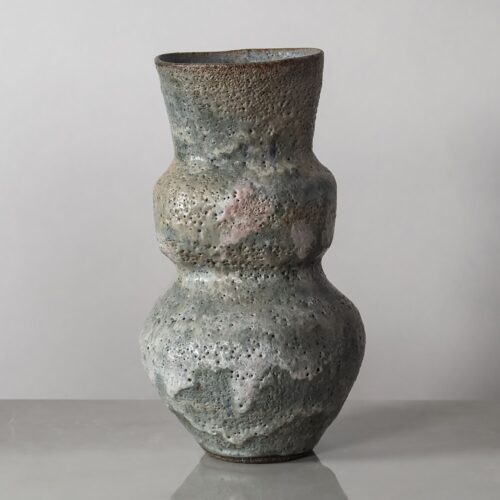
»Unlike her contemporaries, who were mostly making decorative and figurative ceramics, Rie was interested in the material and physical properties of clay and glazes. This can be linked to the modernist interest in truth to materials. She experimented with layering slips and glazes to achieve interesting surface effects,« describes curator Eliza Spindel of the initial phase of her work. In 1938, after Austria’s annexation by the Nazi state, Lucie Rie and her husband emigrated to London. In 1939, in Albion Mews, a then heavily neglected district of London, she discovered a garage with living space above it. The garage was converted into a pottery workshop and remained the focal point of her creative work until her death. To stay financially afloat during and after World War II, Rie primarily produced ceramic buttons and jewelry for fashion houses at that time. »Arriving in London in 1938, Rie found that her work was out of step with prevailing trends in British studio pottery,« says Eliza Spindel in an interview with the magazine STIRworld. She initially adopted the style of her colleague Bernard Leach, who was a few years her senior and a central figure in the British pottery world at the time. »First I tried to follow Bernard Leach’s rules—I made heavier pots and heavier shapes,« Rie describes the influence of her contemporary in a conversation with wildlife filmmaker and self-proclaimed Lucie Rie fan David Attenborough. Gradually, however, she moved away from his style and found her own, which, as Leach himself once noted, was characterized, among other things, by radical independence: »An outstanding quality of Lucie’s work is the degree to which it is free from the direct influence of other potters, ancient and modern.« Sir David Attenborough puts it this way: »Before her time Leach and his followers sought their inspiration from medieval England and twelfth century China. Rie showed how this ancient craft could produce new shapes and new colours.«
MOVED BY BEAUTY
After the war, Rie rediscovered the elegance of her early works, strongly influenced by Modernism. From the late 1950s, she expanded her style with new forms and glazes, including more organic shapes and textured surfaces. Her later work features vibrant colors and metallic glazes that convey a sense of opulence. Retrospectives were dedicated to her in 1967 at the Arts Council Gallery on St. James’s Square, in 1981 at the Sainsbury Centre for Visual Arts, and subsequently at the Victoria & Albert Museum in London. However, Lucie Rie never felt as comfortable in the spotlight as she did in her workshop in Albion Mews. The last major exhibition in which Rie participated as an active ceramist took place in August 1990 at the Sainsbury Centre for Visual Arts in Norwich. The day after the opening, the then 88-year-old suffered a severe stroke, which brought an abrupt end to her pottery career. After her subsequent hospital stay, when asked about her future, she responded with a counter-question: »Haven’t I made enough pots?« Lucie Rie died on April 1, 1995, in her apartment in Albion Mews. In 1999, a solo exhibition was dedicated to her at the Museum of Applied Arts in Vienna.
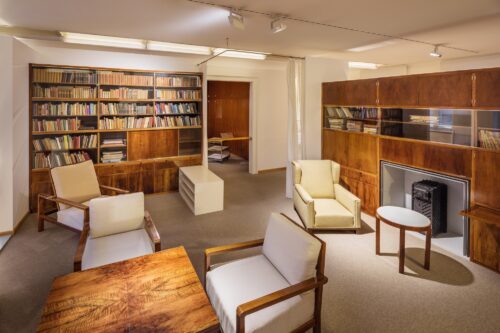
The living and bedroom (1926–1928) designed for Lucie Rie by architect Ernst Plischke for her apartment at Wollzeile 28;
rebuilt at the Hofmobiliendepot, Möbel Museum Wien.
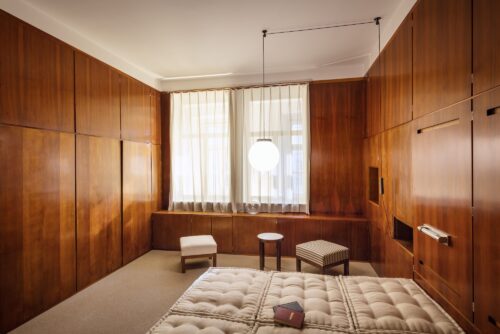
Rie’s pottery studio, which had barely changed over the decades, has been exhibited at the Victoria & Albert Museum in London since 2009. In 2023, a bowl with the deep-drawn footring typical of her work, which lends a special lightness to her pottery, fetched a record sum of £330,200 at an auction by Phillips Auctioneers. Numerous friendships were also central to her work, such as with the aforementioned Bernard Leach, but also with her long-time workshop colleague Hans Coper and with the architect Ernst Plischke, who designed her Vienna apartment in Wollzeile. Rie formed an unusual friendly relationship in old age with the Japanese fashion designer Issey Miyake. Fascinated by her works, he organized an exhibition titled »Issey Miyake meets Lucie Rie« in 1989 at the Sogetsu Gallery in Tokyo. »I am often asked to speak of instances where I have been moved by beauty. Lucie Rie and her work represent some which most often come to mind,« reads a statement by Miyake about Lucie Rie.
PERFECT AND IMPERFECT
Lucie Rie’s successes can also be attributed to her unique technique, unusual for her time. In his biography, Tony Birks describes how colleagues who watched her potting always noted with interest that she used a kidney-shaped piece of metal, a simple tool curved like a comma, in her case made of copper, which replaced fingers in creating smooth surfaces on the inside or outside of a bowl. Furthermore, many of her thin-necked vessels were assembled from two parts. With the exception of her Bernard Leach period, she also meticulously ensured that the upper and lower parts of a ceramic piece were equally cleanly crafted. »Indeed, the bases of numerous works with sgraffito decoration, and also the later so-called knitted vessels, bear very finely incised, sometimes even painted-on patterns after turning, so that viewing her works from that period is akin to a revelation, like the sight of a sea urchin or the delicate drawing of an insect’s body under a magnifying glass,« writes Birks. For the sgraffito or inlay technique, Lucie used a sharp needle as a scoring tool. Radial, parallel lines arranged at an angle to the clay body and fine cross-hatching were typical of her works from the 1950s. Later, she combined cross-hatched sgraffito patterns with heavy glazes.
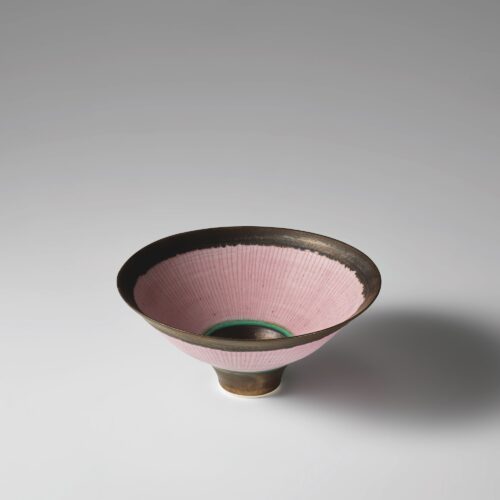
This resulted in the so-called »knitted« vessels. In the foreword to his biography, Tony Birks writes that Lucie Rie’s simple, yet immensely subtle and complex vessels owe their high degree of perfection not to a reduction to an ever clearer form, but equally to their robustness and fragility, a combination of opposites such as economy and abundance, light and shadow. »But it is probably above all the close proximity of perfection and imperfection, the inimitable Lucie Rie’s tremor, that captivates the viewer.« As a person, she embodied the same mixture of opposites, according to Birks. »Her delicate appearance and apparent fragility might sometimes have disguised the fact that she possessed an iron will and was capable of hard work.« The fact that Lucie Rie was not one of those people who constantly revolved around themselves should also be mentioned here. As cliché as it may sound: she always remained firmly grounded. With one exception: In a video showing David Attenborough’s visit to her studio, there is a scene where Lucie Rie dives so deep into her kiln that she loses her footing. Shortly before, in a brief exchange between the naturalist and the artist, the discussion was whether opening the kiln after firing would be akin to a revelation. Laughing, Rie replies: »Not a revelation, a surprise.«
ARTICLE FIRST PUBLISHED IN CHAPTER №XII »SIMPLICITY« — SUMMER 2025

